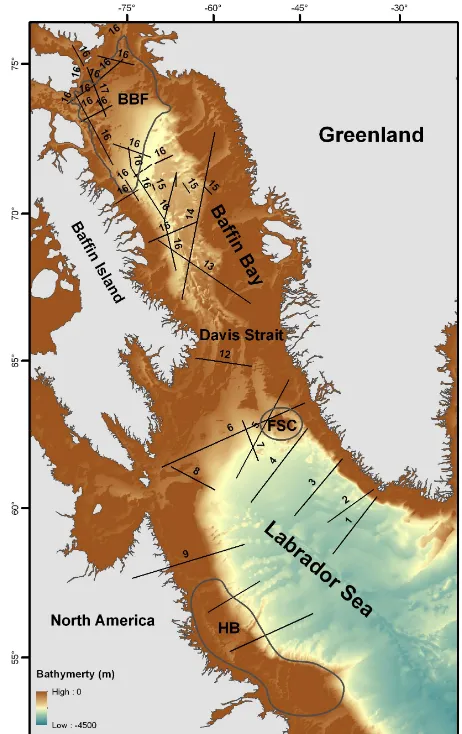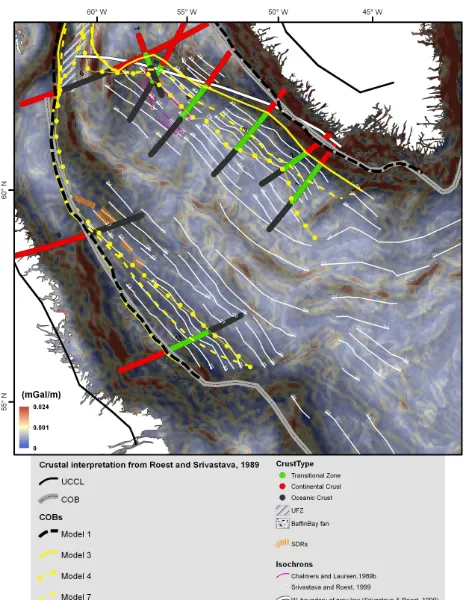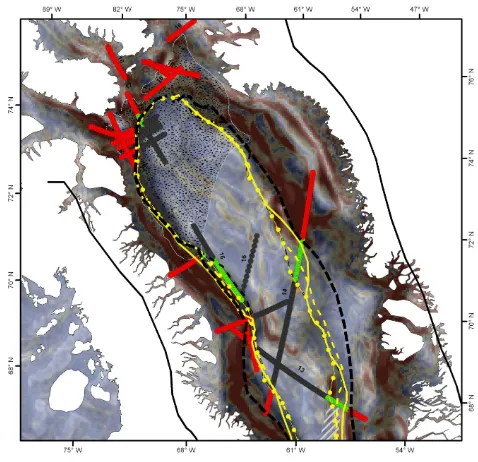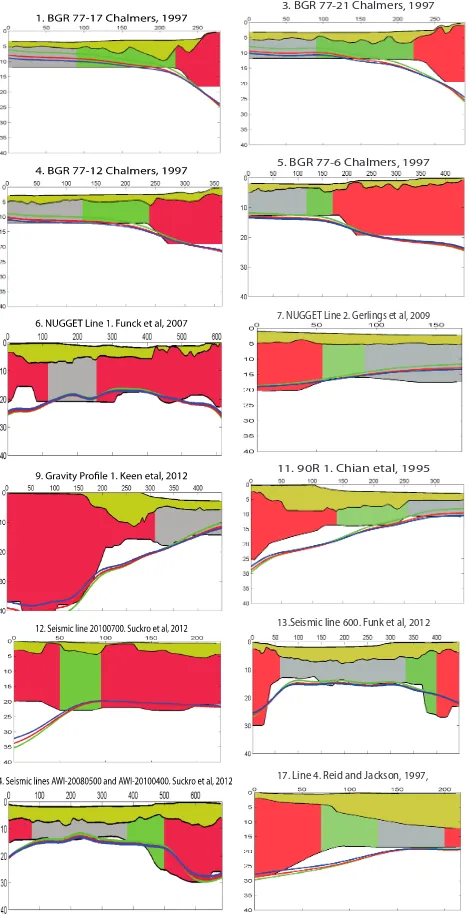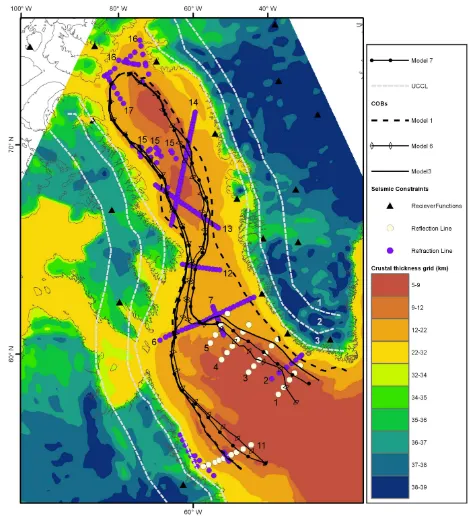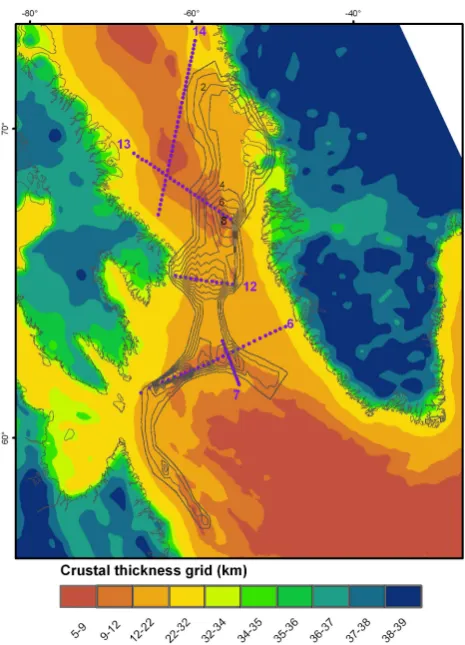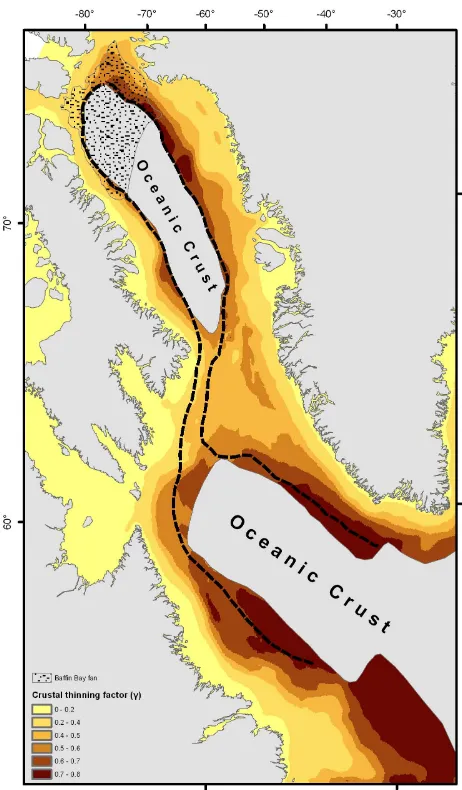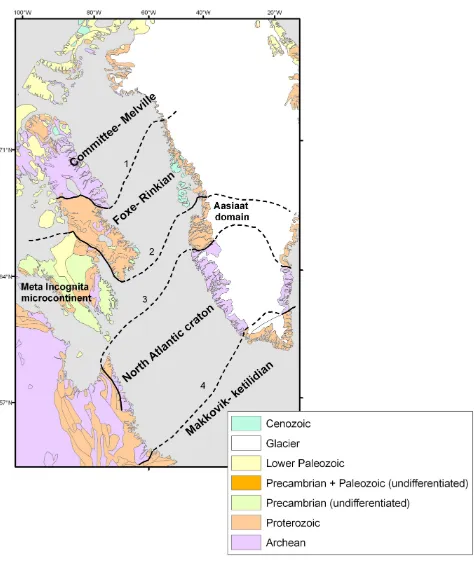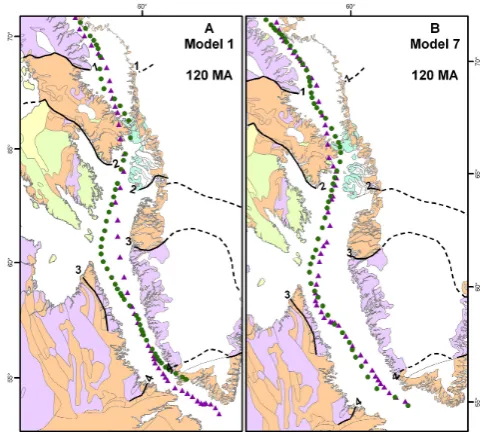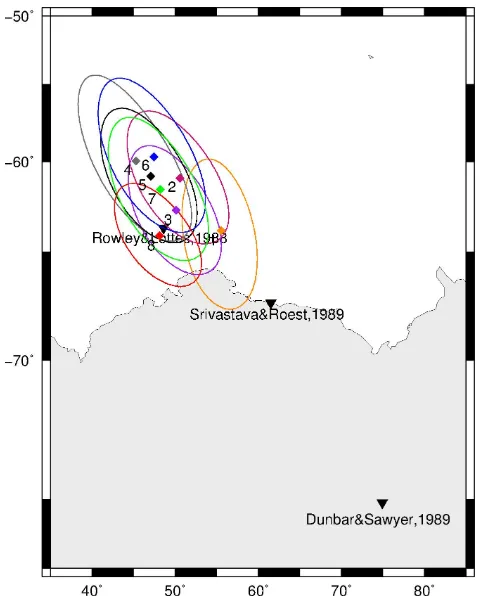www.solid-earth.net/4/461/2013/ doi:10.5194/se-4-461-2013
© Author(s) 2013. CC Attribution 3.0 License.
Solid Earth
Full-fit reconstruction of the Labrador Sea and Baffin Bay
M. Hosseinpour1, R. D. Müller1, S. E. Williams1, and J. M. Whittaker2
1EarthByte Group, School of Geosciences, University of Sydney, Sydney, NSW 2006, Australia 2Institute for Marine and Antarctic Studies, University of Tasmania, Hobart, TAS 7005, Australia
Correspondence to: M. Hosseinpour (maral.hosseinpour@sydney.edu.au)
Received: 7 June 2013 – Published in Solid Earth Discuss.: 8 July 2013
Revised: 25 September 2013 – Accepted: 3 October 2013 – Published: 26 November 2013
Abstract. Reconstructing the opening of the Labrador Sea
and Baffin Bay between Greenland and North America re-mains controversial. Recent seismic data suggest that mag-netic lineations along the margins of the Labrador Sea, orig-inally interpreted as seafloor spreading anomalies, may lie within the crust of the continent–ocean transition. These data also suggest a more seaward extent of continental crust within the Greenland margin near Davis Strait than assumed in previous full-fit reconstructions. Our study focuses on re-constructing the full-fit configuration of Greenland and North America using an approach that considers continental defor-mation in a quantitative manner. We use gravity inversion to map crustal thickness across the conjugate margins, and assimilate observations from available seismic profiles and potential field data to constrain the likely extent of differ-ent crustal types. We derive end-member contindiffer-ental mar-gin restorations following alternative interpretations of pub-lished seismic profiles. The boundaries between continental and oceanic crust (COB) are restored to their pre-stretching locations along small circle motion paths across the region of Cretaceous extension. Restored COBs are fitted quantita-tively to compute alternative total-fit reconstructions. A pre-ferred full-fit model is chosen based on the strongest compat-ibility with geological and geophysical data. Our preferred model suggests that (i) the COB lies oceanward of mag-netic lineations interpreted as magmag-netic anomaly 31 (70 Ma) in the Labrador Sea, (ii) all previously identified magnetic lineations landward of anomaly 27 reflect intrusions into continental crust and (iii) the Ungava fault zone in Davis Strait acted as a leaky transform fault during rifting. This ro-bust plate reconstruction reduces gaps and overlaps in Davis Strait and suggests that there is no need for alternative mod-els proposed for reconstructions of this area including ad-ditional plate boundaries in North America or Greenland.
Our favoured model implies that break-up and formation of continent–ocean transition (COT) first started in the south-ern Labrador Sea and Davis Strait around 88 Ma and then propagated north and southwards up to the onset of real seafloor spreading at 63 Ma in the Labrador Sea. In Baffin Bay, continental stretching lasted longer and actual break-up and seafloor spreading started around 61 Ma (chron 26).
1 Introduction
spreading anomalies could be used to constrain relative plate motions (Roest and Srivastava, 1989). This appears question-able in the light of subsequently collected seismic data, yet the anomaly identifications and reconstructions derived from these interpretations are still used within global-scale com-pilations (Torsvik et al., 2008; Müller et al., 2008; Seton et al., 2012). More recent reconstruction models only con-sider seafloor spreading since chron 27 (63 Ma), the earli-est undebated spreading anomalies (Oakey, 2005; Oakey and Chalmers, 2012).
In this paper we investigate the full-fit configuration of Greenland and North America in the light of available geo-physical and geological data. The distribution of crustal types in the margins of Labrador Sea and Baffin Bay were deter-mined using interpreted seismic lines and other geophysical data to extract the limits of continental deformation. A map of crustal thickness was derived by inversion of gravity data constrained by Moho depth estimates from seismic refrac-tion profiles and receiver funcrefrac-tions. Next, the extended con-tinental crust within the conjugate margins was restored to determine the pre-rift extent of each plate. These boundaries are used as quantitative constraints in generating new poles of rotation for the full-fit configuration of North America and Greenland. We show that previous reconstructions overesti-mate the amount of closure between the two plates. Our new reconstruction, incorporating more recent evidence of the ex-tent of continental crust, reduces the gaps in the Labrador Sea and overlaps in Davis Strait and Baffin Bay which occurred in previous reconstructions of this region.
2 Regional tectonic models
Several authors have presented poles of rotations that de-scribe the relative motions of Greenland and North Amer-ica between the onset of Mesozoic rifting and cessation of seafloor spreading at chron 13 time (34 Ma). Rowley and Lottes (1988) generated stage poles of rotation of Greenland relative to North America in the context of reconstruction of the North Atlantic and Arctic. This reconstruction took into account both onshore geology and offshore geological and geophysical data including magnetic anomalies, frac-ture zones and syn-rift extension data. Dunbar and Sawyer (1989) created another full-fit reconstruction for the cen-tral and North Atlantic including the Labrador Sea with a methodology similar to this study as it treats the continents as non-rigid in the rifting phase. They estimate continental extension from total tectonic subsidence rates of margins and seismic studies and restored the continent-ocean boundaries (COB)s to their pre-rift configurations. Roest and Srivastava (1989) and Srivastava and Roest (1999) introduced poles of rotation from the break-up stage (118 Ma) up to the end of seafloor spreading (34 Ma) in the Labrador Sea based on new interpretation of linear magnetic anomalies, gravity data and fracture zones in this area.
Fig. 1. Bathymetry of the Labrador Sea, Davis Strait and
Baf-fin Bay (Louden et al., 2004). The seismic refraction and reflec-tion lines discussed in this paper are shown as thick black lines 1: Chalmers (1997) line BGR77-17; 2: Chian and Louden (1994) line88R2; 3: Chalmers (1997) line BGR77-21; 4: Chalmers (1997) line BGR77-12; 5: Chalmers (1997) line BGR77-6; 6: Funck et al. (2007) Nugget line1; 7: Gerlings et al. (2009) NUGGET line2; 8: Keen et al. (2012) line TGS1; 9: Keen et al. (2012) Profile1 (Gravity Profile); 10: Keen et al. (2012) line TGS3; 11: Chian et al. (1995a) line90R1; 12: Suckro et al. (2013) line AWI-20080700; 13: Funck et al. (2012) line AWI-20080600; 14: Suckro et al. (2012) com-posite line consisting of AWI-20080500 and AWI-20100400; 15: Keen and Barret (1972); 16: Harrison et al. (2011); 17: Harrison et al. (2011); line3c and Reid and Jackson (1997) line 4. BBF: Baffin Bay Fan; FSC: Fylla Structural Complex; HB: Hopedale Basin.
interval, which correlates with the start of seafloor spread-ing between eastern Greenland and Europe, but no new poles for the earlier rifting. Significantly, these studies do not use spreading anomalies for chrons older than chron 27 on the grounds that these anomalies, used in the reconstructions of earlier authors, were located within the COT and are not true spreading isochrons. This debate is important both for recon-structions of the early seafloor spreading and for delineating and restoring the extended continental crust within each mar-gin, and is discussed further in the next section
3 Tectonic setting
Rifting and the extension of the Labrador Sea started ei-ther in the late Jurassic (160 Ma) based on dating of coast-parallel dykes in SW Greenland or the early Cretaceous (140 Ma), on the basis of distinguishing and dating syn-rift sediments from wells on both margins (Chain and Louden, 1994). These sediments were deposited on top of rift-related volcanics in grabens and half-grabens that formed during continental extension (Srivastava and Roest, 1999; Chalmers and Pulvertaft, 2001). Seafloor spreading in the Labrador Sea started along a branch of the mid-Atlantic in either the late Cretaceous or early Palaeocene times (Roest and Srivastava, 1989; Keen et al., 1993; Srivastava and Roest, 1999; Chian et al., 1995a; Chalmers and Laursen, 1995; Chalmers and Pulvertaft, 2001; Keen et al., 2012) and ceased about 35 Ma (chron 13), leaving an extinct spreading centre in the middle of the basin. The existence of oceanic crust in Baffin Bay was first shown in seismic refraction lines. Magnetic anomalies along these lines were determined in two different directions – NNW–SSE and NW–SE – in this area. These lineations were interpreted as Palaeocene and Eocene extinct spreading ridges (Keen and Barrett, 1972; Keen et al., 1974; Chalmers and Pulvertaft, 2001; Oakey, 2005).
The age of the earliest seafloor spreading magnetic anoma-lies within the Labrador Sea is controversial. The uncer-tainty originates from differing interpretations of the nature of crust within the COT between unequivocal continental and oceanic crust in both margins. Roest and Srivastava (1989) interpreted this zone as oceanic crust containing linear mag-netic anomalies 31–33 formed during slow seafloor spread-ing (Fig. 2). Other authors interpreted this crust as exhumed and serpentinised mantle or high-velocity igneous crust over-lain by thin oceanic basalts, highly fractured and hydrother-mally altered (Chian and Louden, 1994; Lundin and Dore, 2011; Keen et al., 2012). Some other studies (Chian and Louden, 1994, Chian et al., 1995a, b; Reston, 2009; Dickie et al., 2011) conclude that seafloor spreading starts sometimes between chron 31 and chron 27. This interpretation is based on data derived from seismic lines, subsidence history and stratigraphic characteristics of both margins. Nonetheless, Chalmers (1991), Chalmers and Laursen (1995), Chalmers and Pulvertaft (2001) and Funck et al. (2007) interpreted
Fig. 2. Interpreted crustal structure and alternative COB models in
the Labrador Sea shown overlying Bouguer gravity (derived from EGM08). UCCL (black) line is the same for all models. Four al-ternative COB interpretations are shown: model 1 (dashed black line) is based on Roest and Srivastava (1989) crustal interpreta-tion, model 3 (continuous thick yellow line) is the most landward COB (same as model 2 in the Labrador Sea), model 4 (yellow line with circles) is the most oceanward COB (same as model 5 in the Labrador Sea) and Model 7 (dashed yellow line) interprets the COB within the range of the transitional zone (same as model 6 in the Labrador Sea). The numbering for seismic lines is the same as Fig. 1.
these anomalies as being a result of magmatic intrusion into highly thinned and stretched continental crust based on inter-pretation of reflection seismic profiles and that the oldest true seafloor spreading anomaly is chron 27 (Fig. 2).
The nature of the crust within Davis Strait is also debated. Chalmers and Pulvertaft (2001) describe the entire crust in Davis Strait as continental, while Srivastava (1983) described sedimentary basins flanking Davis Strait High as oceanic, whereas they stated that the nature of the crust in the base-ment high of Davis Strait could be described as continental.
Fig. 3. Interpreted crustal structure and alternative COB models in
Davis Strait. Key is the same as for Fig. 2.
to penetrate and fill it as new oceanic crust (Storey et al., 1998; Funck et al., 2007) or as a mixture of continental crust and plume related material (Keen and Barrett, 1972).
The Oakey and Chalmers (2012) reconstruction of chron 27–25 suggests a Palaeocene extensional phase along the UFZ continued as a transpressional tectonic regime during the Eocene. In their model, this structural inversion leads to the formation of the Davis Strait High, a structural feature that resulted from over-thrusting of Precambrian and Ordovi-cian continental units onto Palaeogene volcanic rocks.
Uncertainty in the extent of continental crust and nature of the COT continues northward of Davis Strait in south-ern Baffin Bay mostly on the Greenland margin. Funck et al. (2012) interpret a northward extension of the UFZ as a continuation of the leaky transform fault. Remnants of con-tinental crust or a transform fault associated with UFZ lay between this zone and normal oceanic crust of Baffin Bay (Chalmers and Pulvertaft, 2001; Funck et al., 2012). Another interpretation defines this zone as Palaeocene oceanic crust (Oakey and Chalmers, 2012; Funck et al., 2012; Suckro et al., 2012). In comparison, along the Baffin Island margin the continent-ocean boundary is much sharper, recognisable by a strong positive gravity high all along the margin (Fig. 4).
Both margins in the northernmost area of Baffin Bay have been interpreted as non-volcanic with basement highs and faulted continental crust, a rough basement of exhumed and serpentinised mantle and submarine basalts within the in-terpreted COT, and smoother oceanic crust with only weak magnetic anomalies (Whittaker et al., 1997; Skaarup et al., 2006). Oceanic crust terminates in northern Baffin Bay at about 76◦N (Reid and Jackson, 1997; Oakey and Stephen-son, 2008).
Fig. 4. Interpreted crustal structure and alternative COB models in
Baffin Bay. Key is the same as for Fig. 2.
4 Methodology
4.1 Delineation of crustal types across the COT
38 949
Figure 5. Seismic profiles showing crustal type interpreted from different studies, 950
locations shown in Figs. 1 to 4. Red – continental crust, green – transitional crust, grey - 951
oceanic crust, yellow - sediments. Coloured lines show crustal thickness computed using 952
gravity inversion; blue (for initial crustal thickness of 37km and density of 500kg/m3), 953
red (for initial crustal thickness of 38km and density of 450kg/m3) and green (for initial 954
crustal thickness of 40km and density of 400kg/m3). 955
6. NUGGET Line 1. Funck et al, 2007
14. Seismic lines AWI-20080500 and AWI-20100400. Suckro et al, 2012 4. BGR 77-12 Chalmers, 1997
1. BGR 77-17 Chalmers, 1997 3. BGR 77-21 Chalmers, 1997
5. BGR 77-6 Chalmers, 1997
12. Seismic line 20100700. Suckro et al, 2012
7. NUGGET Line 2. Gerlings et al, 2009
11. 90R 1. Chian etal, 1995
13.Seismic line 600. Funk et al, 2012
17. Line 4. Reid and Jackson, 1997, 9. Gravity Profile 1. Keen etal, 2012
Fig. 5. Seismic profiles showing crustal type interpreted from
differ-ent studies, locations shown in Figs. 1 to 4. Red – contindiffer-ental crust; green – transitional crust; grey – oceanic crust; yellow – sediments. Coloured lines show crustal thickness computed using gravity in-version: blue for initial crustal thickness of 37 km and density of 500 kg m−3, red for initial crustal thickness of 38 km and density of 450 kg m−3, and green for initial crustal thickness of 40 km and density of 400 kg m−3.
Keen et al., 2012; Oakey and Chalmers, 2012; Suckro et al., 2013).
We generated alternative plate reconstructions using the end-member scenarios for the COT, allowing us to investi-gate the effect of uncertainty in the extent of continental crust on the full-fit reconstruction between Greenland and North
America. These different models can be summarised as fol-lows:
1. An extremely landward COB based on the definition of Srivastava and Roest (1989). This model assumes that the COB lies at the edge of the continental shelf along the Greenland margin. The position of this boundary is less clear on the Labrador margin because thinned and extended continental crust is wider here (Srivas-tava and Roest, 1999). Further north, through Davis Strait, a more landward COB implies oceanic crust for the area and follows the continental shelf in both Greenland and Baffin Island margins.
2. The most landward COB (within the limits of cur-rent seismic interpretations). The COB is located at the landward limit of the COT and assumes that the entire Davis Strait underlain with continental crust.
3. The same as (2) in the Labrador Sea and Baffin Bay but assumes the existence of a narrow strip of oceanic crust described as Ungava leaky transform fault pass-ing through the western edge of the Davis Strait High. 4. The most oceanward COB (within the limits of current seismic interpretations). The oceanward boundary of the COT was taken as the COB in the Labrador Sea and Baffin Bay. This model assumes the presence of continental crust across the entire Davis Strait. 5. The same as (4) but assuming the UFZ is a leaky
trans-form fault and that Davis Strait contains oceanic crust. 6. The COB falls within the COT permitted by seismic reflection data. In the Labrador Sea the COB is lo-cated landward of chron 31 (70 Ma) assuming this isochron as the first seafloor spreading anomaly in this region. This model is based on the assumption that Davis Strait is continental.
7. The same as (6) but with narrow strip of ocean crust in Davis Strait.
4.2 Generating the crustal thickness grid
Fig. 6. Grids used to generate crustal thickness maps based on
the gravity inversion method of Chappell and Kusznir (2008). (A) Bathymetry (Louden et al., 2004) (B) free-air gravity (Sandwell and Smith, 2009) (C) sediment thickness (Louden et al., 2004; Divins, 2003; Bassin et al., 2000). (D) Age grid modified from Müller et al. (2008).
2000; Fig. 6c) and subtracted these from the observed free-air gravity. The gravity effect of mantle thermal variations was estimated on the basis of seafloor age (Müller et al., 2008; Fig. 6d). The need to correct for mantle density variations is supported by the 2-D gravity model of Keen et al (2012), who showed that a lower mantle density was necessary be-neath the Labrador Sea compared to the flanking continents in order to match gravity and seismic observations. The re-maining gravity signal is inverted using the method of Parker (1972) to derive a map of depth to the Moho (Fig. 7). A com-plete description of the workflow is provided in Appendix A. Crustal density, initial crustal thickness and the seafloor age grid influence the results of this method, so we performed sensitivity tests to investigate the influence of these parame-ters on the resulting crustal thickness and chose the combi-nation of a reference crustal thickness of 37 km and a den-sity contrast across the Moho of 500 kg m−3 that results in
Fig. 7. Crustal thickness grid computed using the gravity inversion
method. We defined three sets of UCCL for conjugate margins to examine the effect of changing the unstretched crust limit of re-stored COBs. UCCL number 1 is the most inland limit and corre-sponds to the crustal thickness∼40 km. Numbers 2 and 3 represent the limit of∼37 and∼34 km respectively. The seismic line num-bers are the same as Fig. 1. Receiver functions on Greenland are from Dahl-Jensen et al. (2003). The North American receiver func-tions derived from Darbyshire (2003) and Ramesh et al. (2002).
the lowest RMS to produce the crustal thickness grid. These sensitivity tests are discussed in detail in Appendix A and Fig. A1.
For this step in our workflow we defined a region with a high likelihood of being affected by the addition of late Cretaceous–Tertiary igneous material. The zone spans the northern Labrador Sea and Davis Strait and extends north-ward to the southern Baffin Bay and Disko Island region (Fig. 8). Constraints on the distribution and thickness of the igneous crust come from the seismic lines mentioned above. Where no seismic data are available, especially on the Green-land margin near Disko IsGreen-land from 67 to 72° N, we use the western Greenland/Baffin Island Tertiary volcanic distribu-tion maps of Chalmers and Pulvertaft (2001) and Skaarup et al. (2006). The thickness of volcanic addition in these off-shore regions is poorly constrained, but the total extrusive sequence onshore varies from 3 to 5 km around Disko Island, with 2 km suggested as a minimum estimate for the average thickness across the onshore and offshore regions (Storey et al., 1998). The considerable thickness of extrusives suggests that an equivalent or greater thickness of intrusive volcanic bodies in the lower crust could also be present (White et al., 2008). In this study we assumed a thickness of igneous ma-terial up to 4 km across the areas not constrained by seismic profiles. The estimated thickness of igneous additions to the stretched continental crust was subtracted from the crustal thickness grid, and the restoration of COBs repeated with the corrected crustal thickness grid.
The resulting crustal thickness grid (Fig. 7) shows that continental crustal thickness varies from around 40 km for inland cratons of North America and Greenland to less than 9 km under extremely thinned and stretched continental crust adjacent to both margins. Figure 9 illustrates the compari-son between Moho depths from seismic experiments and the Moho depth extracted from gravity inversion along each of the seismic profiles being used in this study (Fig. 1). We also compare our database of seismic refraction (violet circles in Fig. 7) and receiver function (black triangles in Fig. 7) depths (Jackson and Reid, 1994; Hall et al., 2002; Ramesh et al., 2002; Darbyshire, 2003; Dahl-Jensen et al., 2003) with the Moho depth contained within the CRUST2 model of global crustal structure (Bassin et al., 2000). The comparison shows that the global grid gives typically deeper Moho compared with individual seismic profiles and suggests that the grav-ity inversion method will yield more robust crustal thickness restoration.
A lithospheric thinning factor (γ) grid illustrates the im-plications for crustal stretching of our crustal thickness grid. The parameterγ is derived from the lithospheric stretching factor beta (β) and taking into account the addition of ig-neous material added to the crust during rifting:
β=tc0/tc1, (1)
where tc0 is the initial unstretched continental crustal thick-ness used to produce the crustal thickthick-ness grid and tc1 is the crustal thickness at present day.
Fig. 8. The crustal thickness grid after elimination of igneous layers.
Thin grey contour lines show the extent and the amount of igneous crust in km. Seismic data that has been used in determining the amount and distribution of igneous material have been shown in violet circles. The seismic line numbers are the same as Fig. 1.
The gamma factorγ is calculated using
γ=(1−1/β). (2)
0 5 10 15 20 25 30 35 40 45 50 0
5 10 15 20 25 30 35 40 45 50
Depth to Moho from seismic refraction (km)
Depth to Moho from grid (km)
Seismic versus CRUST2.0 Seismic vs Gravity Vintage Seismic vs Gravity
Fig. 9. Comparison of depth to Moho between independent
seis-mic interpretations presented in Fig. 1, a global crustal thick-ness map (CRUST2 model) (Bassin et al., 2000) and our com-puted crustal thickness from gravity inversion. Dark-grey circles show seismic depths versus gravity-inversion-derived Moho depths. Squares show the Moho depths from pre-2000 seismic studies ver-sus gravity depth. Light-grey circles show seismic depths verver-sus CRUST2 model depths. Depths from CRUST2 model are typically deeper compared to regional seismic data. The grey dashed line is a 1:1 trend.
This massive volume of sedimentary cover makes the grav-ity data unable to detect basin slope topography, which leads to greater uncertainty in computed crustal thickness in this region. Defining COBs in this area mainly relies on seismic profiles.
4.3 Restoring extended crust between UCCL and COB
boundaries
For each model, the extended continental crust between the COB and UCCL was restored along each margin to an un-stretched thickness. The UCCL has been placed to where the crust starts thinning and the crustal thickness grid was used to derive this limit (Fig. 7). However, we used seis-mic profiles and teleseisseis-mic data analysed via receiver func-tions in both North America (Hall et al., 2002; Ramesh et al., 2002; Darbyshire, 2003) and Greenland (Gohl and Smithson, 1993; Jackson and Reid, 1994; Dahl-Jensen et al., 2003) to-gether with gravity-inversion-derived crustal thicknesses on the Greenland side (Braun et al., 2007; Welford and Hall, 2013) to further double-check and reinforce our interpreted UCCL location. Previous studies suggest that the unstretched
Fig. 10. Crustal thinning factor (γ) grid varies between 0 in un-stretched continental crust and more than 0.7, which is the represen-tative of volcanic addition in the form of magmatic underplating or oceanic crust. The thick dashed line is our preferred COB (model 7) that remains approximately atγ=0.5–0.7
crustal thickness changes from 30 to 46 km in North America and 33 to 48 km in western and central Greenland.
in southern Labrador, where the crustal thickness from grav-ity data was underestimated.
Based on this information and to resolve the effect of changing this limit for the COB restoration and final fit, we defined three sets of UCCLs at 35, 37 and 40 km crustal thickness boundaries and restored the COBs of model 7 with each of them (Figs. 7 and B3). Distribution of the crust with thickness more than 40 km is limited, so we set the upper limit of the UCCL range to around 40km. The location of the UCCL for all other models is fixed at 37 km and the only difference is in the position of COBs along both mar-gins. We used the stage poles of rotation of Roest and Sri-vastava (1999) for restoration, which represent the direc-tion of the modirec-tion of extended continental crust during the rifting between Greenland and North America. These stage poles of relative motion were used to generate small cir-cle motion paths between two limits of extended continen-tal crust. Cruscontinen-tal thicknesses from the cruscontinen-tal thickness grid are then extracted along these small circles to estimate the thickness of crust between two boundaries. Next, we calcu-late the length of this crust before extension and restore the crust to its initial reference thickness before being subjected to extension. Applying the change in crustal length along the given small circle gives the restored COB (RCOB). Repeat-ing this process for all small circles along the margins results in a continuous model for the RCOB location.
4.4 Reconstruction of restored COBs
For each model described above, we use the generated RCOBs to compute poles of rotation for the pre-rift fit between Greenland and North America. The computation of Euler poles of rotation has been performed using the Hellinger (1981) least-squares fitting method. This method is typically applied to reconstructions of seafloor spreading using isochrons and fracture zones as constraints. Here, we apply the method to derive full-fit poles of rotation in the same manner as used for the Australia–Antarctic margins by Williams et al. (2011). The Euler pole of rotation calcu-lated for the alternative models from the beginning of rift-ing (120 Ma) to the start of seafloor spreadrift-ing (chron 27, 63 Ma). All reconstructions are using crustal thickness grids derived from the gravity inversion method in which igneous crust added to the thinned continental crust is removed. North America is considered as the fixed plate in all reconstruc-tions. The main inputs for geometrical fitting of the margins are the RCOBs, which constrain the amount of closure be-tween the two plates. To constrain the lateral juxtaposition of Greenland and North America prior to rifting, we use older structural features and terranes mapped and correlated be-tween these two continents as follows (Fig. 12):
1. Southern border of Committee–Melville orogen (CMO) separating this area in the north from Foxe– Rinkian fold belt in the Baffin Island and Greenland margins (Dawes, 2009).
2. Baffin and Disko Bugt suture zones (DBS) that closed at approximately 1.88 Ga. The Baffin suture zone thrust the Meta Incognita microcontinent over the Cumberland Batholith in North America. Similarly, closure of the DBS in Greenland led to the expansion of the Aasiaat domain over the Rae craton (St-Onge et al., 2012).
3. Nordre Isortoq suture zone (NIS) (1.86–1.84 Ga) that formed due to collision of the Aassiaat domain with the Archean North Atlantic craton along the northern boundaries of the latter.
4. Kanairiktok shear zone (1.89–1.8 Ga) that separates Makkovik province on the Canadian side and Ketilid-ian orogen on the Greenland side from the Archean North Atlantic craton.
5 Results
We carried out restoration and reconstruction of RCOBs for the all end-member models discussed above. Restored COB locations and small circle paths for model 1 and 7 are pre-sented in Fig. 11; the restored COBs and small circle paths for the other proposed models can be found in Appendix B, Fig. B1. Model 1 is very similar to the Srivastava and Roest (1989) model in terms of what they proposed as the location of COB, which put the COB in the most landward position compared to all other models. Model 7 resulted in the best fit amongst all examined models
The most dramatic differences in the position of the RCOB occur in the Greenland margin in the northern Labrador Sea near Davis Strait. Davis Strait shows the greatest amount of extension in all models, which is mostly concentrated on the Greenland margin. The smallest amount of continental exten-sion was observed in the model 1, where the most landward COB follows the continental slope (Fig. 11a). The amount of continental extension in this model varies between 6 and 100 km in both margins. This amount of extension is the least in comparison with the other models, implying less continen-tal thinning.
The position of the restored COBs along both margins in Baffin Bay does not change significantly for all tested mod-els. In all models, small circles show a NW–SE direction of extension and are perpendicular or highly oblique to the coastline.
Full-fit reconstructions for our preferred model 7 and for model 1 are shown in Fig. 13. Table 1 summarises the loca-tion of Euler poles for full-fit reconstrucloca-tions and their errors for all models, whereas Table 2 reviews the parameters used to calculate the rotation poles. See Appendix B, Fig. B2 for reconstructions for the other models presented here.
Fig. 11. Restored COBs on North America and Greenland margins
together with small circle paths showing the direction of restora-tion. The dashed lines are the UCCL and COB lines before the restoration was performed. The background is total horizontal gra-dient of Bouguer gravity map. Model 1: Srivastava and Roest (1989) COBs. Model 7: our preferred model assuming the COB in the range of COT, and UFZ as leaky transform fault in Davis Strait. Restored COB locations: triangles – Greenland margin; circles – North American margin.
north of Disko Island (Fig. 13). This model is very similar to the Srivastava and Roest (1989) reconstruction for the on-set of rifting except that model 1 locates Greenland slightly further south relative to North America.
The most dramatic improvement in the fit reconstruction of model 7 is achieved in the northern Labrador Sea and Davis Strait, which are the two most problematic and contro-versial regions. This model reinforces the hypothesis of the existence of a narrow Palaeocene oceanic basin in that re-gion. Figure B2-H (model 8) demonstrates the full-fit recon-struction using the UCCL-COB borders of model 7, while it uses the crustal thickness grid excluded from the igneous post-rift material. Model 8 appears to slightly increase the adjustment of restored COBs, especially in the Labrador Sea and Davis Strait when compared to model 7; however, due to lots of uncertainties in placement and the amount of under-plated material, especially where we lack seismic data, this model should be treated more carefully. Our proposed mod-els correlate juxtaposed Precambrian rocks in North America and Greenland margins well.
6 Discussion
6.1 Non-rigid Greenland–North America
Previous attempts to reconstruct Cretaceous rifting between Greenland and North America have produced major gaps
Fig. 12. Geological map of North America and Greenland
(Bouysse, 2010) used for lateral correlation of two margins. We use sedimentary formations and rock units older than Palaeozoic to cor-relate the full-fit alignment of the conjugate margins. Numbers refer to structural features separating those units and formations that have been mentioned and discussed in more detail in the main text.
Table 1. Full-fit rotation parameters for alternative models of Greenland relative to North America (fixed) discussed in this paper. The chron
27 pole of rotation derived from Oakey and Chalmers (2012) has also been represented.
Full fit (120 Ma)
Model Latitude Longitude Angle r κˆ dF N s (deg) (deg) (deg) (km)
1 63.92 −124.47 −13.51 946.01 0.12 116 127 4 2 61.00 −129.40 −11.16 644.74 0.16 106 117 4 3 62.82 −129.87 −11.28 634.35 0.17 109 120 4 4 59.98 −134.69 −9.67 818.34 0.15 123 134 4 5 60.88 −132.94 −10.00 672.62 0.17 116 127 4 6 59.73 −132.55 −10.23 769.08 0.13 106 117 4 7 61.67 −131.80 −10.47 678.16 0.15 107 118 4 8 64.18 −131.88 −10.67 435.79 0.23 104 115 4
Chron 27 27.8 −150.0 −3.75
Parameters arer, total misfit;κˆ, estimated quality factor; dF, degree of freedom;N, number of data points; ands, number of great circle segments. Model 8 uses the same COBs as model 7 except that the restoration has been performed using the crustal thickness grid with igneous material subtracting from it.
Table 2. Rotation covariance for North America–Greenland
recon-structions.
Model a b c d e f
1 9.08 7.57 1.79 3.10 −9.56 7.31 2 1.11 3.29 2.75 2.77 −3.23 1.18 3 1.00 7.80 2.45 2.19 −2.27 9.94 4 1.12 −9.90 2.99 1.85 −2.56 1.20 5 8.80 5.66 2.17 2.06 −2.38 9.56 6 9.62 4.57 2.45 2.24 −2.62 1.09 7 9.63 9.13 2.39 2.13 −2.39 1.03 8 7.81 −1.20 2.12 1.96 −2.81 1.00
The covariance matrix is given by the formulaκ1×
a b c b d e c e f
×10−g, where
the values “a” to “f” are given in radians squared.
shear zones crossing central Greenland on the basis of what Beh et al. (1975) suggested considering geological informa-tion and the physiography of the glacial channels running through Greenland. A similar shear zone has been contem-plated in a recent Arctic reconstruction (Winefield et al., 2011). These structures have been mapped only in the Ar-chaean and Proterozoic rocks near the margin and the con-tinuation of these tectonic features inland and under the ice cover of the Greenland, and any reactivation and displace-ment along these faults during late Cretaceous rifting is as yet undocumented.
Our analysis suggests that full-fit reconstructions treating Greenland and North America as rigid blocks with deform-ing margins achieve a relatively good overall fit, includdeform-ing in areas such as Davis Strait, where the distribution of crustal types remains unclear. Our preferred model 7, as well as the range of models presented here testing the sensitivity of our results to different starting assumptions, shows that internal
Fig. 13. Full-fit (120 Ma) plate reconstruction of North America–
Greenland margins. North America restored COB – green circles; Greenland restored COB – purple triangles. (A) Model 1 results in a major overlap in the northern Labrador Sea near Davis Strait.
(B) Model 7 minimises the mismatch in this area and results in a
good fit in both the Labrador Sea and Baffin Bay. Structural lines are the same as Fig. 11 and are represented here to show the lateral juxtaposing of the margins.
Fig. 14. Comparison of previously published and our computed
Eu-ler poles with 95 % uncertainty ellipses. The numbers represent the models described in the text.
6.2 Comparing previous models and our preferred
model
Figure 14 shows the comparison between the location of the Euler poles and their uncertainty ellipses of our alternative models together with the full-fit Euler poles from previous studies. The Euler poles resulting from different models pro-posed here vary within a very limited geographical range and their error ellipses mostly overlap. The pole resulting from model 1 is the closest to the rotation pole proposed by Sri-vastava and Roest (1989). This similarity can be explained by the almost identical interpretations of these models con-cerning the nature of the crust adjacent to both margins. Of the previously published models, the full-fit rotation pole of Rowley and Lottes (1988) is located closest to model 8. The smaller error ellipse of model number 8 compared with all other models is noticeable.
6.3 Continental rift phase
Our reconstruction based on restoring extended continental crust gives us a full-fit reconstruction pole at the onset of con-tinental rifting (∼120 Ma). Since the oldest reliable seafloor spreading isochron within the Labrador Sea is chron 27, the next more recent time for which we have a quantitatively
constrained reconstruction is∼63 Ma (Oakey and Chalmers, 2012). We now use our preferred reconstruction and COT configuration to investigate the diachronous transition from continental rifting to the onset of formation of the transition zone and seafloor spreading, assuming a constant rate and direction of rotation of Greenland away from North Amer-ica and considering possible deviations from this simple as-sumption.
Fig. 15. Reconstruction of the rifting and seafloor spreading in the
Labrador Sea and Baffin Bay. The models use the rotation pole from model 7 UCCL and COBs (purple lines) for the rifting period (120 up to 63 Ma). Seafloor spreading (63 Ma and younger) has been re-constructed using Oakey and Chalmers (2012) poles of rotation.
Tectonostratigraphic studies of the North American mar-gin of the Labrador Sea also show an early rifting phase during the early Cretaceous, characterised by widespread ex-tensional faulting and formation of grabens and half-grabens (Dickie et al., 2011). Regional unconformities in the mid-Cretaceous (100–83 Ma) are considered too early to be re-lated to continental breakup, and may instead be rere-lated to changes in the magnitude and/or direction of the stress field (Dickie et al., 2012, and references therein).
Subsidence curves calculated from wells in the Hopedale Basin (Fig. 1) consistently show the onset of rapid subsi-dence around 70 Ma, interpreted to coincide with the onset of seafloor spreading in the Labrador Sea (Dickie et al., 2012).
A limitation of using crustal thickness restoration is that these data do not allow us to quantitatively constrain changes in plate motion during the rifting. Our reconstruction de-scribes the overall motion between Greenland and North America from the beginning of rifting (∼120 Ma) until the time of the earliest seafloor spreading anomaly (63 Ma), which varies from ENE–WSW in the southern Labrador Sea to NE–SW in Baffin Bay. The studies discussed above are consistent with the overall motion implied by our reconstruc-tion while providing evidence for distinct stages within this overall motion. However, the available data are insufficient to constrain this in a quantitative manner. As shown for the Aus-tralian and Antarctic margin, reconstructions derived using the method applied here are relatively insensitive to changes in the direction of relative plate motions (Williams et al., 2011). Hence our reconstruction forms a starting point for more detailed models of Cretaceous continental rifting be-tween Greenland and North America.
7 Conclusions
We derive a new full-fit reconstruction that restores the Greenland and North American plates to their configuration prior to Cretaceous rifting. In contrast to previous early Cre-taceous reconstructions, our study incorporates new interpre-tations of thinned and stretched crust in the margins of the Labrador Sea, Baffin Bay and Davis Strait as either a conti-nental or transitional crust consisting of a mixture of serpen-tinised mantle with slivers of continental crust and igneous material. We quantify the extension and thinning of continen-tal crust and restore the COBs to their pre-rift configuration and test the sensitivity of these results to different interpreta-tions of the crustal types within the COT. The model that best fits the entire region (model 7) was generated with a COB within the bounds of all available seismic interpretations and oceanward of magnetic anomalies previously interpreted as chron 31 in the Labrador Sea. Within the best-fitting model, the UFZ is considered as a leaky transform fault that pro-duces a narrow strip of igneous crust through Davis Strait.
Appendix A
Mapping crustal thickness by gravity inversion
We derived a map of Moho depth for the Labrador Sea, Davis Strait and Baffin Bay by inversion of gravity data; our method follows an approach similar to that used by Green-halgh and Kusznir (2007) and Chappell and Kusznir (2008) to map crustal thickness at continental margins of the north-east Atlantic. We estimate and strip away the gravity effects of sea water, sediment layers and density variations within the mantle based on variation in the age of oceanic litho-sphere.
We use gravity data derived from satellite altimetry over the oceans (Sandwell and Smith, 2009), which incorpo-rates the EGM08 gravity model for onshore areas. We cal-culated an onshore simple Bouguer correction using the EGM08 elevation model and a Bouguer correction density of 2.67 g cc−1. For Greenland, the corrections also take into account the thickness of ice taken from (Bamber et al., 2001) and use a density for ice of 0.91 g cc−1.
To estimate the gravity effect of the sediment layers, we use sediment thickness grids from Louden et al. (2004) for the Labrador Sea and Davis Strait. We merged this map with less detailed data for Baffin Bay taken from the compilations of Divins (2003) and Bassin et al. (2000). A 3-D distribution of sediment density was derived using a depth–density func-tion based on the equafunc-tions and empirically derived constants given by Sawyer (1985).
A lithosphere thermal gravity anomaly correction was cal-culated by first deriving a 3-D model of the lithosphere tem-perature beneath the basin. Beneath the oceanic lithosphere the thermal structure is estimated using a 1-D cooling model (McKenzie, 1978), which provides an adequate approxima-tion to 2-D thermal models (Chappell and Kusznir, 2008). For the distribution of seafloor age we use a modified ver-sion of the age grid presented by Müller et al. (2008). The grid of Müller et al. (2008) contains ocean crust in Davis Strait and along the Labrador Sea margins based on the in-terpretation of seafloor up to chron 33 age from Roest and Srivastava (1989). As discussed in the main text, a synthesis of currently available seismic profile interpretations suggests much of this area is underlain by either stretched continen-tal crust or the COT; see Figs. 2 to 5. We therefore mask the Müller et al. (2008) age grid to for these areas. Following Breivik et al. (1999) and Kimbell et al. (2004), we model the temperature in the region of stretched continental crust is modelled using a ramp between the oceanic domain and a separate model for the lithosphere temperature under stable continental areas. In this way a 3-D grid of lithospheric tem-perature field is calculated at a resolution of 5 km. From this, we derive a 3-D density field and gravity field observed at the surface as described by Chappell and Kusznir (2008).
After application of all the gravity corrections described above, the remaining gravity signal is inverted using the method of Parker (1972) to derive a map of depth to the Moho. The results are influenced by a range of assumptions involved, notably the density contrast across the Moho, and the reference Moho depth. (The thickness of crust corre-sponds to zero bathymetry and zero long-wavelength free-air gravity; Alvey et al., 2008). We tested a range of pa-rameter combinations (Fig. A1) and validated the results by plotting the gravity inversion depths against independent es-timates of the Moho depth from seismic refraction profiles and receiver functions studies at onshore seismic stations. The lowest RMS difference between the gravity and seis-mic refraction corresponds to a reference depth of 37 km and density contrast across the Moho of 500 kg m−3 (the RMS for values of 38 km and 450 kg m−3 are very similar). The reference depth is important for our purpose, since we use this value as the thickness of continental crust prior to exten-sion in the cross-section area balancing. We find the value used for the reference Moho depths (Zref) has two counter-acting effects on the location of the restored COB locations. A larger Zref value yields a greater volume of continental crust within the margin, so it tends to move the RCOB loca-tion more oceanward; however, the larger Zref is also used in the area-balancing and it moves the RCOB landward.
Fig. A1. Verification of the credibility of gravity inversion method and the resulting crustal thickness grid. The results were tested by
Fig. B1.Restoration of present-day COBs in to their pre-rift positions in conjugate margins. The restoration has been applied for the all eight models in this study. UCCL lines and present-day COBs have been shown in grey dashed lines, while the restored COBs are shown as black circles for the North America and black triangles for the Greenland margin. Thin solid lines are small circle paths showing the direction of mo-tion during the restoramo-tion process. The background map is the total horizontal gradient of Bouguer gravity map corrected from EGM08 gravity model.
Fig. B3. 95 % uncertainty ellipses for model 7 running with three
different sets of UCCL. 7(1) corresponds to the crustal thickness
∼40 km. Numbers 2 and 3 are are the limit of 37 and 34 km respec-tively.
Supplementary material related to this article is available online at http://www.solid-earth.net/4/461/ 2013/se-4-461-2013-supplement.zip.
Acknowledgements. M. Hosseinpour, S. E. Williams and R. D. Müller gratefully acknowledge the support received from the ARC through grant no. FL0992245. M. Hosseinpour also expresses gratitude for the CSIRO OCE Ph.D. scholarship. J. M. Whittaker wishes to thank Statoil for the support provided. We also thank F. Rossetti for their constructive reviews.
Edited by: F. Rossetti
References
Alvey, A., Gaina, C., Kusznir, N., and Torsvik, T.: Integrated crustal thickness mapping and plate reconstructions for the high Arctic, Earth Planet. Sci. Lett., 274, 310–321, 2001.
Bak, J., Korstgård, J., and Sørensen, K.: A major shear zone within the Nagssugtoqidian of West Greenland, Tectonophysics, 27, 191–209, 1975.
Bamber, J. L., Layberry, R. L., and Gogineni, S. P.: A new ice thick-ness and bed data set for the Greenland ice sheet 1. Measurement, data reduction, and errors, J. Geophys. Res.-Atmos., 106, 33773– 33780, 2001.
Bassin, C., Laske, G., and Masters, G.: The current limits of resolu-tion of surface wave tomography in North America, EOS Trans AGU, F897, 2000.
Beh, R. L.: Evolution and geology of western Baffin Bay and Davis Strait, Canada, 1975.
Braun, A., Kim, H. R., Csatho, B., and von Frese, R. R.: Gravity-inferred crustal thickness of greenland, Earth Planet Sc. Lett., 262, 138–158, 2007.
Breivik, A. J., Verhoef, J., and Faleide, J. I.: Effect of thermal con-trasts on gravity modeling at passive margins: Results from the western Barents Sea, J. Geophys. Res.-Sol. Ea., 104, 15293– 15311, 1999.
Bullard, E., Everett, J. E., Smith, A. G., and Everett, J.: The fit of the continents around the atlantic, Philos. Trans. R. Soc. Lond. A, 258, 41–51, 1965.
Chalmers, J. and Pulvertaft, T.: Development of the continental mar-gins of the labrador sea: A review, Geol. Soc. London Spec. Publ., 187, 77–105, 2001.
Chalmers, J. A.: New evidence on the structure of the labrador sea/greenland continental margin, J. Geol. Soc., 148, 899–908, 1991.
Chalmers, J. A. and Laursen, K. H.: Labrador sea: The extent of continental and oceanic crust and the timing of the onset of seafloor spreading, Mar. Petrol. Geol., 12, 205–217, 1995. Chappell, A. and Kusznir, N.: Three-dimensional gravity inversion
for moho depth at rifted continental margins incorporating a lithosphere thermal gravity anomaly correction, Geophys. J. Int., 174, 1–13, 2008.
Chian, D. and Louden, K. E.: The continent-ocean crustal transi-tion across the southwest greenland margin, J. Geophys. Res., 99, 9117–9135, 1994.
Chian, D. P., Louden, K. E., and Reid, I.: Crustal structure of the labrador sea conjugate margin and implications for the formation of nonvolcanic continental margins, J. Geophys. Res.-Sol. Ea. 100, 24239–24253, 1995a.
Chian, D., Keen, C., Reid, I. and Louden, K. E.: Evolution of non-volcanic rifted margins: New results from the conjugate margins of the labrador sea, Geology, 23, 589–592, 1995b.
Crosby, A., White, N., Edwards, G., Thompson, M., Corfield, R., and Mackay, L.: Evolution of deep-water rifted margins: Test-ing depth-dependent extensional models, Tectonics, 30, TC1004, doi:10.1029/2010TC002687, 2011.
Dawes, P. R.: Precambrian–Palaeozoic geology of Smith Sound, Canada and Greenland: key constraint to palaeogeographic reconstructions of northern Laurentia and the North At-lantic region, Terra Nova., 21, 1–13, doi:10.1111/j.1365-3121.2008.00845.x, 2009.
Dickie, K., Keen, C. E., Williams, G. L., and Dehler, S. A.: Tectonostratigraphic evolution of the labrador margin, atlantic canada, Mar. Petrol. Geol., 28, 1663–1675, 2011.
Divins, D.: Total sediment thickness of the world’s oceans and marginal seas, 2003.
Divins, D. L.: Total sediment thickness of the world’s oceans and marginal seas, 2004.
Dunbar, J. A. and Sawyer, D. S.: Patterns of continental extension along the conjugate margins of the central and north atlantic oceans and labrador sea, Tectonics, 8, 1059–1077, 1989. Funck, T., Jackson, H., Louden, K., and Klingelhöfer, F.: Seismic
study of the transform-rifted margin in davis strait between baf-fin island (Canada) and greenland: What happens when a plume meets a transform-art, J. Geophys. Res.-Sol. Ea. 112, B04402, doi:10.1029/2006JB004308, 2007.
Funck, T., Gohl, K., Damm, V., and Heyde, I.: Tectonic evolution of southern baffin bay and davis strait: Results from a seismic refraction transect between canada and greenland, J. Geophys. Res., 117, B04107, doi:10.1029/2011JB009110, 2012.
Gerlings, J., Funck, T., Jackson, H. R., Louden, K. E., and Klingel-höfer, F.: Seismic evidence for plume-derived volcanism during formation of the continental margin in southern davis strait and northern labrador sea, Geophys. J. Int., 176, 980–994, 2009. Gradstein, F. M., Ogg, J. G., and Schmitz, M. (Eds.): The Geologic
Time Scale 2012, 2-volume set, Elsevier, 2012.
Greenhalgh, E. E. and Kusznir, N. J.: Evidence for thin oceanic crust on the extinct aegir ridge, norwegian basin, ne atlantic derived from satellite gravity inversion, Geophys. Res. Lett. 34, L06305, doi:10.1029/2007gl029440, 2007.
Harrison, J., Brent, T., and Oakey, G.: Baffin fan and its inverted rift system of arctic eastern canada: Stratigraphy, tectonics and petroleum resource potential, Geol. Soc. London Memoirs, 35, 595–626, 2011.
Hellinger, S. J.: The uncertainties of finite rotations in plate tecton-ics, J. Geophys. Res., 86, 9312–9318, 1981.
Jackson, G. and Iannelli, T.: Rift-related cyclic sedimentation in the neohelikian borden basin, northern baffin island, Pap. Geol. Surv. Can., 81–10, 1981.
Keen, C. and Barrett, D.: Seismic refraction studies in baffin bay: An example of a developing ocean basin*, Geophys. J. Roy. Astr. S., 30, 253–271, 1972.
Keen, C. E., Keen, M. J., Ross, D. I., and Lack, M.: Baffin bay: Small ocean basin formed by sea-floor spreading, Am. Assoc. Petrol. Geol. Bull., 58, 1089–1108, 1974.
Keen, C., Potter, P., and Srivastava, S.: Deep seismic reflection data across the conjugate margins of the labrador sea, Can. J. Earth Sci., 31, 192–205, 1994.
Keen, C. E., Dickie, K., and Dehler, S. A.: The volcanic margins of the northern labrador sea: Insights to the rifting process, Tecton-ics, 31, TC1011, doi:10.1029/2011TC002985, 2012.
Kimbell, G. S., Gatliff, R. W., Ritchie, J. D., Walker, A. S. D., and Williamson, J. P.: Regional three-dimensional gravity modelling of the ne atlantic margin, Basin Res., 16, 259–278, doi:10.1111/J.1365-2117.2004.00232.X, 2004.
Kuzsnir, N.: South australia-antarctica conjugate rifted margins: Mapping crustal thickness and lithosphere thinning using satel-lite gravity inversion, 2009.
Lawver, L. A. and Müller, R. D.: Iceland hotspot track, Geology, 22, 311–314, 1994.
Louden, K. E., Tucholke, B. E., and Oakey, G. N.: Regional anoma-lies of sediment thickness, basement depth and isostatic crustal thickness in the north atlantic ocean, Earth Planet Sc. Lett. 224, 193–211, 2004.
Lundin, E. R. and Dore, A. G.: Hyperextension, serpentinization, and weakening: A new paradigm for rifted margin compressional deformation, Geology, 39, 347–350, 2011.
McKenzie, D.: Some remarks on the development of sedimentary basins, Earth Planet Sc. Lett., 40, 25–32, 1978.
Müller, R. D., Sdrolias, M., Gaina, C., and Roest, W. R.: Age, spreading rates and spreading asymmetry of the world’s ocean crust, Geochem. Geophys. Geosyst., 9, Q04006, doi:10.1029/2007GC001743, 2008.
Jackson, H. R. and Reid, I.: Crustal thickness variations between the greenland and ellesmere island margins determined from seismic refraction, Can. J. Earth Sci., 31, 1407–1418, 1994.
Oakey, G. N.: Cenozoic evolution and lithosphere dynamics of the baffin bay-nares strait region of arctic canada and greenland, 233 pp., Unpublished Ph. D. thesis, Vrije Universiteit, Amsterdam, The Netherlands, 2005.
Oakey, G. N. and Chalmers, J. A.: A new model for the paleo-gene motion of greenland relative to north america: Plate re-constructions of the davis strait and nares strait regions between canada and greenland, J. Geophys. Res.-Sol. Ea., 117, B10401, doi:10.1029/2011JB008942, 2012.
Oakey, G. N. and Stephenson, R.: Crustal structure of the innuitian region of arctic canada and greenland from gravity modelling: Implications for the palaeogene eurekan orogen, Geophys. J. Int., 173, 1039–1063, 2008.
Okulitch, A., Dawes, P., Higgins, A., Soper, N., and Christie, R.: Towards a nares strait solution: Structural studies on southeast-ern ellesmere island and northwestsoutheast-ern greenland, Mar. Geol., 93, 369–384, 1990.
Parker, R. L.: The rapid calculation of potential anomalies, Geo-phys. J. Roy. Astr. S., 31, 447–455, 1972.
Ramesh, D., Kind, R., and Yuan, X.: Receiver function analysis of the north american crust and upper mantle, Geophys. J. Int., 150, 91–108, 2002.
Reid, I. and Jackson, H. R.: Crustal structure of northern baffin bay: Seismic refraction results and tectonic implications, J. Geophys. Res.-Sol. Ea., 102, 523–542, 1997.
Roest, W. R. and Srivastava, S. P.: Seafloor spreading in the labrador sea: A new reconstruction, Geology, 17, 1000–1004, 1989. Rowley, D. B. and Lottes, A. L.: Plate-kinematic reconstructions of
the north atlantic and arctic: Late jurassic to present, Tectono-physics, 155, 73–120, 1988.
Sandwell, D. T. and Smith, W. H. F.: Global marine gravity from retracked geosat and ers-1 altimetry: Ridge segmenta-tion versus spreading rate, J. Geophys. Res., 114, B01411, doi:10.1029/2008JB006008, 2009.
Sawyer, D. S.: Total tectonic subsidence: A parameter for distin-guishing crust type at the U.S. Atlantic continental margin, J. Geophys Res., 90, 7751–7769, 1985.
Seton, M., Müller, R., Zahirovic, S., Gaina, C., Torsvik, T., Shep-hard, G., Talsma, A., Gurnis, M., Turner, M., and Chandler, M.: Global continental and ocean basin reconstructions since 200 ma, Earth Sci. Rev., 113, 212–270, 2012.
Skaarup, N., Jackson, H. R., and Oakey, G.: Margin segmentation of baffin bay/davis strait, eastern canada based on seismic reflection and potential field data, Mar. Petrol. Geol., 23, 127–144, 2006. Srivastava, S. P.: Davis strait: Structures, origin and evolution,
in: Structure and development of the greenland-scotland ridge, edited by: Bott, M. H. P., Saxov, S., Talwani, M., and Thiede, J., Plenum, 159–189, 1983.
Nares Strait and the drift of Greenland: a conflict in plate tec-tonics, edited by: Dawes, P. R. and Kerr, J. W., Meddelelser om Grønland, Geoscience, 8, 339–352, 1982.
Srivastava, S. P. and Roest, W. R.: Extent of oceanic crust in the labrador sea, Mar. Petrol. Geol., 16, 65–84, 1999.
St-Onge, M. R., Van Gool, J. A., Garde, A. A., and Scott, D. J.: Cor-relation of archaean and palaeoproterozoic units between north-eastern canada and western greenland: Constraining the pre-collisional upper plate accretionary history of the trans-hudson orogen, Geol. Soc. Lond. Spec. Publ., 318, 193–235, 2009. Storey, M., Duncan, R. A., Pedersen, A. K., Larsen, L. M., and
Larsen, H. C.: Ar-40/ar-39 geochronology of the west greenland tertiary volcanic province, Earth Planet Sc. Lett. 160, 569–586, 1998.
Suckro, S. K., Gohl, K., Funck, T., Heyde, I., Ehrhardt, A., Schreck-enberger, B., Gerlings, J., Damm, V., and Jokat, W.: The crustal structure of southern baffin bay: Implications from a seismic re-fraction experiment, Geophys. J. Int., 190, 37–58, 2012. Suckro, S. K., Gohl, K., Funck, T., Heyde, I., Schreckenberger, B.,
Gerlings, J., and Damm, V.: The davis strait crust – a transform margin between two oceanic basins, Geophys. J. Int., 193, 78–97, 2013.
Torsvik, T. H., Muller, R. D., Van der Voo, R., Steinberger, B., and Gaina, C.: Global plate motion frames: Toward a unified model, Rev. Geophys., 46, RG3004, doi:10.1029/2007RG000227, 2008. Whittaker, R. C., Hamann, N. E., and Pulvertaft, T.: A new frontier province offshore northwest greenland: Structure, basin develop-ment, and petroleum potential of the melville bay area, AAPG Bull., 81, 978–998, 1997.
Williams, S. E., Whittaker, J. M., and Müller, R. D.: Full-fit, palinspastic reconstruction of the conjugate australian-antarctic margins, Tectonics, 30, 1–21, 2011.
Wilson, R. W., Klint, K. E. S., van Gool, J. A., McCaffrey, K. J., Holdsworth, R. E., and Chalmers, J. A.: Faults and fractures in central west greenland: Onshore expression of continental break-up and sea-floor spreading in the labrador–baffin bay sea, GEUS Bull., 11, 185–204, 2006.
